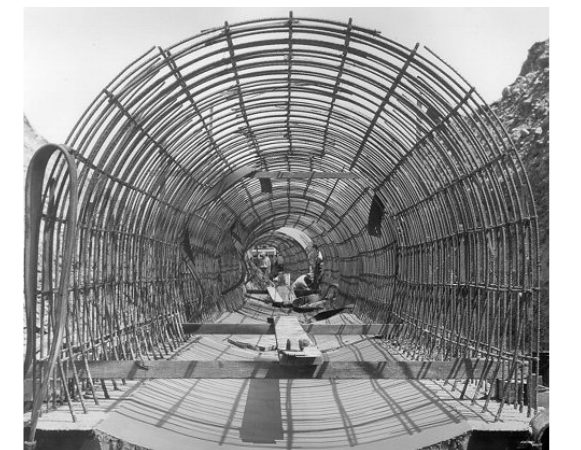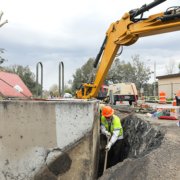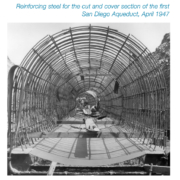Work Begins on Water Authority’s Historic First Aqueduct
The San Diego County Water Authority’s First Aqueduct will be shut down periodically over the next four months for maintenance projects to ensure a safe and reliable water supply for the region. A series of three shutdowns on the First Aqueduct is scheduled from December through March, when portions of the aqueduct will be relined, along with other maintenance.
The Water Authority and its member agencies are coordinating to minimize impacts to residents and businesses, while servicing pipelines that are more than 65 years old.
Customers of these affected retail agencies during the Dec. 5-14 shutdown should check with their local water utility if they have questions about localized impacts: Fallbrook Public Utility District, Rainbow Municipal Water District, Rincon del Diablo Municipal Water District, Vallecitos Water District, Valley Center Municipal Water District, Vista Irrigation District, and the Yuima Municipal Water District.
Proactive Asset Management Program
“Proactively managing our water delivery system in coordination with our member agencies ensures we continue to provide a safe and reliable supply that serves the region’s 3.3 million residents and our $240 billion economy,” said Eva Plajzer, the Water Authority’s director of operations and maintenance. “It requires an extraordinary amount of work each fall and winter during the shutdown season to take care of this critical infrastructure.”
Maintenance work on pipelines is scheduled during low-demand periods to minimize impacts on water service. The other scheduled shutdowns on the First Aqueduct are January 23 to February 1 and February 27 to March 8. The February 27 to March 8 shutdown will also impact the Helix Water District and the cities of San Diego, Poway and Ramona.
Historic First Aqueduct
The historic First Aqueduct was constructed in the 1940s with Pipeline 1 and in the 1950s with Pipeline 2. On November 28, 1947, the first Colorado River water flowed south from Riverside County for 71 miles into the City of San Diego’s San Vicente Reservoir via the First Aqueduct.

By order of President Franklin D. Roosevelt, the U.S. Navy built the San Diego Aqueduct to deliver Colorado River water to San Diego. Photo: San Diego County Water Authority archives
Asset Management Program
The Water Authority’s Asset Management Program is a key element of providing safe and reliable water supplies to the region. The agency continually assesses and inspects its 310 miles of large-diameter pipelines, which provide treated and untreated water to 24 member agencies in San Diego County. The program is widely recognized for pioneering work – including a patented inspection device – that promotes water affordability by avoiding costly unplanned disruptions in service.
As assets age, the Water Authority proactively replaces and repairs them to minimize impacts to member agencies and the public. Investments in the latest inspection technologies, including electromagnetic scanning, robotic inspections and 3D tunnel inspections help the Water Authority’s asset management team detect defects in pipelines and related facilities. Identifying potential issues early avoids more costly fixes later.
(Editor’s Note:The Fallbrook Public Utility District, Rainbow Municipal Water District, Rincon del Diablo Municipal Water District, Vallecitos Water District, Valley Center Municipal Water District, Vista Irrigation District, and the Yuima Municipal Water District are seven of the San Diego County Water Authority’s 24 member agencies that deliver water across the metropolitan San Diego region.)





